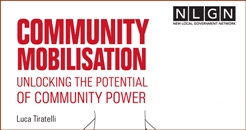 Let's continue to build community - community mobilisation
Let's continue to build community - community mobilisation
From a report by New Local Government Network
Something that is increasingly being recognised across the public sector is that when communities come together, they have the power to do extraordinary things, as shown in the Covid-19 pandemic.
Public bodies of all kinds are realising that they can no longer go it alone, and that they do their best work, and make their most robust decisions, when they are working hand-in-hand with the communities they serve. But how can we develop communities to the point at which their potential can be fully realised?
This is where community mobilisation comes in and a report, "Community Mobilisation - Unlocking the potential of community power" offers a how-to guide for organisations interested in the mobilisation process, illustrating a range of potential strategies to build active, networked and powerful communities.
This report also offers four take home messages for public bodies interested in community mobilisation in practice. They are:
Catalyse, don't lead
Communities direct; mobilisers facilitate. It is not the role of representatives from public sector bodies to lead communities to a predetermined destination – their efforts are better focussed on helping communities get to wherever it is they themselves want to be.
Listen
True mobilisation can only occur around issues that are genuinely salient to the communities in question. These are not easily identified by external actors, and as such, listening is key. Listening is also crucial for building the trusting, positive relationships between representatives of public bodies and communities that are a prerequisite for successful projects.
Build something
Successful community mobilisation initiatives build something that was not there before. This may be something physical, like housing or infrastructure. It might also involve less tangible assets, such as new networks or bonds between people and institutions.
Have clear goals
Despite the fact that it is up to communities themselves to direct the process of mobilisation, it remains the case that in order to successfully design a project, public bodies need to have an idea of what they want to achieve. This does not have to be something overly specific – but simply being clear about whether, for example, the main focus is to reduce frontline demand, or to reform a particular service. This will help the approach come together.
If these ideas are successfully embodied, any of the approaches to community mobilisation outlined in this report have the power to transform places for the better. When done well, the process of mobilisation can bind people together, create new types of public services, and recast the relationship between citizens and the state. It can also create resilience and ensure that communities have the power to address and withstand the challenges of today.
Watch this 30 second video:
Sorry, your browser is unable to play this type of file.
You can still
download it
Download the report from here.
Retweet about this article:
From a report by New Local Government Network, 01/09/2020